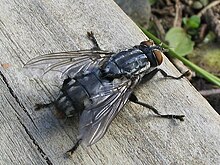Hexapoda
| Hexapods Temporal range: Early Devonian–Recent |
|
|---|---|
 |
|
| A flesh-fly | |
| Scientific classification | |
| Kingdom: | Animalia |
| Phylum: | Arthropoda |
| Clade: | Pancrustacea |
| Subphylum: |
Hexapoda Latreille, 1825 |
| Classes & Orders | |
|
Class Insecta (insects) |
|
Class Insecta (insects)
Class Entognatha
The subphylum Hexapoda (from the Greek for six legs) constitutes the largest number of species of arthropods and includes the insects as well as three much smaller groups of wingless arthropods: Collembola, Protura, and Diplura (all of these were once considered insects). The Collembola (or springtails) are very abundant in terrestrial environments. Hexapods are named for their most distinctive feature: a consolidated thorax with three pairs of legs. Most other arthropods have more than three pairs of legs.
Hexapods have bodies ranging in length from 0.5 mm to over 300 mm which are divided into an anterior head, thorax, and posterior abdomen. The head is composed of a presegmental acron that usually bears eyes (absent in Protura and Diplura), followed by six segments, all closely fused together, with the following appendages:
The mouth lies between the fourth and fifth segments and is covered by a projection from the sixth, called the labrum (upper lip). In true insects (class Insecta) the mouthparts are exposed or ectognathous, while in other groups they are enveloped or endognathous. Similar appendages are found on the heads of Myriapoda and Crustacea, although these have secondary antennae.
The thorax is composed of three segments, each of which bears a single pair of legs. As is typical of arthropods adapted to life on land, each leg has only a single walking branch composed of five segments, without the gill branches found in some other arthropods and with gill on the abdominal segments of some immature aquatic insects. In most insects the second and third thoracic segments also support wings. It has been suggested that these may be homologous to the gill branches of crustaceans, or they may have developed from extensions of the segments themselves.
...
Wikipedia
